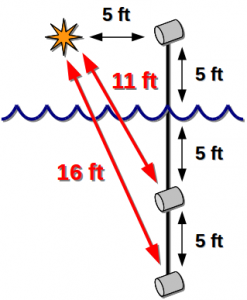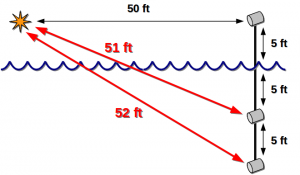That’s crazy! I mean, it’s the same amount of material that it’s passing through.
Tory Bellaci
There was a lot to like about this episode. Anytime you can get a remote-controlled car to drive through a hail of gunfire, I’m watching. Unfortunately, some of the groundwork they laid with their terminal ballistic research was a bit shoddy.
Terminal Ballistics
My biggest problem is that for some reason, they think you can evaluate armor by looking at a projectile’s depth of penetration (DOP) into an essentially semi-infinite target, and then use that distance to define the final armor thickness.
They repeated this mistake time and time again throughout the phone book part of this episode. First they shot through their modified car door, backed by 10 phone books. They saw that the M14 almost made it to the back of the first phone book of their stack. Then they jumped to the conclusion that it would have been stopped without the other nine books backing it up. Then they shot through a bunch of phone books backing a car window, and they observed that it only went through three phone books. So they only need three phone books!
Wrong on both accounts.
While the observation that the glass does some work in blunting the projectile is probably true*, I’d bet a pound to pennies that if they had shot the window backed by only three phone books (as opposed to their setup where the window was sandwiched), they would have also seen the bullet fly straight through. This is because the integrity of the back of the target is enhanced by additional material behind it. You are almost never going to “just stop” a projectile; you will always need some amount of armor behind it with enough strength left to “catch” the projectile. Would it have killed them to actually try this to confirm their speculation?! They could have busted the myth they just created!
If I think of a better example, I’ll give it, but for now, think of the simple case of trying to stop a baseball with paper. If I stack a bunch of phone books up and hurl a baseball at them, it will bounce right off. Following the Mythbuster’s logic, that means I’d only need one sheet of paper to stop it. Of course, that’s not true; a baseball would rip a hole right trough a piece of paper without the help of all the pieces of paper behind it.
Let’s use a quick diagram to drive the point home. Here, the three phone books are contributing to stop the bullet. In fact, the bullet stops in the second phone book. However, removing the green phone book means there’s not enough structural integrity behind the yellow phone book anymore. Repeating the test, the bullet would have no problem tearing through that last bit of yellow book and going along its merry way.
Really quick aside: I don’t want to mislead anyone into thinking that the solution is to add one more phone book than you think you need and you’ll be fine. It depends on a lot of variables, not least of which is the thickness of the phone book in question. It’s hard to know a priori what you need; you mostly just have to shoot it multiple times to see how it performs.
When evaluating a specific armor (let’s concentrate on homogeneous armor, made from a single material), engineers define V50 for a given projectile. That is, the speed at which 50 percent of the projectiles will be stopped, and 50 percent will defeat the armor. And the funny thing is, when a projectile defeats armor, it will virtually always be carrying a head of steam behind it (as we saw when they shot their sandwiched window). The projectiles that go through at V50 are still carrying a significant portion of their velocity with them. In the same vein, projectiles that are stopped will only go through a fraction of the armor (maybe a large fraction, but not all the way to the back of the armor).
* Armor designers are actually acutely aware of the power blunting a projectile can have on stopping power. So are projectile designers, which is why we have armor-piercing rounds, which aim to retain a streamlined profile.
Transmission of Shock Waves
 I mostly liked what they did with the experiments to see whether it was safer to be underwater than not when an explosion goes off. But I think they may have come to the right conclusion for the wrong reasons. Not that their full-scale experiment was terrible, but I don’t think it was very fair.
I mostly liked what they did with the experiments to see whether it was safer to be underwater than not when an explosion goes off. But I think they may have come to the right conclusion for the wrong reasons. Not that their full-scale experiment was terrible, but I don’t think it was very fair.
When they set up their burst-discs, they spaced them from the explosive at intervals (5, 10, 20, 50 feet) and above and below the water (5 feet above, 5, 10 feet below the water line). However, their explosives all seemed to be located approximately 5 feet above the water themselves. A little geometry shows how problematic this can be. When the above water distance from the explosion was 5 feet, the below water discs are actually 11 and 16 feet respectively. The disparity is less dramatic the further you get away, so I think their last test with TNT is pretty indicative of the protection water affords.
But why does water afford protection at all? Well, it’s actually pretty simple. Anytime a wave front reaches a transition of materials (media), two things happen. Part of the wave is transmitted, and part is reflected (and of course, energy is conserved!). The degree to which the wave is transmitted has to do with how similar the two materials are (or aren’t). So there’s nothing special about water. It’s just not air. If the explosion occurred underwater, the reverse would be true, and you’d be exposed to less overpressure if you were out of the water!



